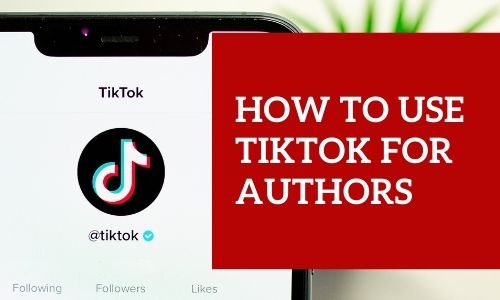 By Jori Hanna
By Jori Hanna
Over the last few years, and especially over the Covid-19 pandemic, TikTok has become one of the most powerful social media platforms available to authors and influencers.
TikTok has a proven track record of taking someone who is relatively unknown and giving them a seemingly unlimited stage. As one of the top ten most used social media platforms, TikTok is becoming the space to be.
As an author, it is likely that you’ll be able to reach your audience on other platforms (such as Instagram or Facebook.) Most TikTok users also use multiple platforms, and that means your content will be available to them if they can find you.
But that’s the kicker. Discovering a new creator on Instagram or Facebook almost always requires a user referral—one of your friends shares something by a page they follow, and you decide to follow that page or account as well.
TikTok and YouTube are the exceptions to this near rule of social media, and more platforms are finding ways to use this system to keep people on their apps. Instagram released Reels as a way to compete with TikTok’s short-form video content, and YouTube released YouTube Shorts.
Neither algorithm is quite as good as TikTok’s at giving users what they routinely enjoy watching, however. So if you’re not interested in TikTok because you’ve heard it’s just music and dances, we have good news. TikTok is not “just music and dances.” And if you’re not interested in seeing the latest dance to the latest song, don’t worry. You have some distinct ways to tip TikTok off that you don’t want to see those.
First, let’s talk about the way the app is set up.
The main navigation menu is located along the bottom of the screen, giving you the options of Home, Friends (a new update), the Create button, your Inbox (or notifications), and then your profile.
Along the top of the screen on the Home page, you’ll first see Live, Following, For You, and then a search option. Down the right-hand side you’ll see the creator’s account for the video you’re watching, likes, comments, share options, and then the icon for whatever sound is being used in the video. This sound is also seen scrolling across the bottom of the video, under the creator’s caption.
Before we continue, let’s define some terms.
Creator: any person with a TikTok account who creates video content and uploads it on their profile.
Profile: a creator’s central space on the app—like a website, an Instagram grid, or a Facebook account profile or page.
Sound: Each video uploaded to TikTok adds to a massive sound library searchable and useable by every other creator on TikTok. Sounds trend (this is how you get “TikTok dances”) and people will often Lip Synch to different sounds, using these to create content on their page.
Filter: If you’re familiar with Snapchat or Instagram, TikTok has a similar filter function which places a filter in the video feed of your screen. Filters offer everything from makeup to randomized photo pickers creators often use like the sorting hat from Harry Potter or a Buzzfeed quiz to let them know which character they are from a favorite show, what type of houseplant they would be, or which book they are from those famous on BookTok.
Stitch: Videos can be posted by one creator and then quoted by another. This is called a Stitch. A Stitch allows you to select 10 seconds of someone else’s video and then create a video reaction in response.
Duet: Videos can be posted by one creator and then reacted to in real-time by another. This is called a Duet. (This probably stems from the app’s musical origins, as two creators can sing together in a duet with this feature.) Duets are often used for blind reactions, normal reactions, and general re-posts of content you’d like to share from another creator’s account.
BookTok: Any video about books or reading, often showing off your current read, posting book reviews, or creating bookish humor, tagged with the hashtag #BookTok. As of February 11, 2022, there were 39.2 billion views on videos in this hashtag.
Like most social media, videos can be sorted in multiple ways. Videos can be sorted by sound, hashtag, or account. Videos can also be created in response to comments, allowing multiple forms of conversation and video linking (much like a thread on Twitter.)
So how do you use TikTok as an author, and which authors should use it?
Option 1: Create a BookTok, and occasionally talk about your own books.
This option will work best for you if you read voraciously. One of the most complicated aspects of joining any book-focused online community is that your reading schedule must keep up with posting demands. If you consistently read a book a week, this may be a good fit for you. If you don’t, you may have a hard time creating enough content featuring new books regularly enough to keep an engaged audience. But the focus of this account should be on books written by other people. It is a BookTok account first and foremost.
Option 2: Create a personality account, and occasionally talk about your own books.
If you like to read but you only have time for leisure reading and between work, social activities, writing, and family time you only have time for 1-12 books a year, this may be a better fit for you. Start telling stories from your life while you walk your dog. Share your thoughts about the things that linger in your mind. Maybe you read a good book recently or a poem that stuck with you. Talk about why it stuck with you and the thoughts it spurred on for about a minute. This option gives you the most flexibility, as you can easily use this type of account to talk about events, book signings, book releases, and other publishing-related life events, but it also gives you a stage to share what you’re reading, what you’re creating, and the other bizarre things that happen to you on a regular basis.
Option 3: Create an AuthorTok account, and give a behind-the-scenes look at your writing process, your books, and everything in between.
If writing is a major part of your life, you may find this the easiest account to create. Much like #BookTok, #AuthorTok is a gathering place online for authors of all sorts of genres and all walks of life—traditionally published, hybrid-published, or self-published. There is one caveat here: this content will be most attractive to other writers, and won’t necessarily get you into reader’s circles. If your goal with TikTok is to get to readers, this may not be your best bet. But if you want a community of authors to talk about writing with, this may be exactly the right online space for you.
Before you join in any of these spaces, make sure you spend quite a bit of time getting to know the app and the different spaces. There are tons and tons of different “sides” of TikTok. BookTok, ReadingTok, and AuthorTok are only the tip of the iceberg. There’s also FashionTok, CoffeeTok, GardenTok, CosplayTok, CrownTok, QueenTok, DnDTok, and many, many others. One of those areas may fit into your life more than you expected.
This is where the For You page (the FYP, if you’re active and in the TikTok lingo) comes in.
The Home page will default to your For You page. This page shows you what the TikTok algorithm thinks you’ll like. The algorithm takes into account the videos you watch all the way through, the videos you like, the videos you comment on, the videos you share, the hashtags you follow, the accounts you linger on, the terms you search, on and on and on. The more videos you interact with when you first get the app (interact meaning like, comment, share, or follow) the sooner TikTok will become a more accurate depiction of what you genuinely want to see. This algorithm is powerful, and it is often correct. (There’s a running meme that “if this video is on your For You page, you’re probably XYZ.” Most often, these videos are created to gain followers of people with similar interests. These videos are extremely effective.)
As a creator, your goal should be to get on people’s For You pages. This is the wonderful thing about TikTok. No matter how niche the audience—in fact sometimes the most niche videos are the ones that do the best—TikTok will try to find an audience for the content you’ve created. This is wonderful news. The other wonderful news is that you don’t have to be particularly clever or witty when you create content. Because of the way the app is designed with filters and sounds, there is always something new you can put out into the world, even if you don’t have much creativity that day.
BookTok has bookshelf scavenger hunt sounds where you search your shelf to find books matching different qualities in the sound (a book with stars on the cover, a book with “Sun” in the title, a book written by a woman of color, a book in your favorite genre, a book you never get to talk about, etc.) These videos don’t have to include your face, and you don’t even have to have a pretty bookshelf. You can take the books off, make your bed, and then film the covers on your bedspread.
If you’re a speaker and your speaking events are often recorded, it’s common practice in the Standup Comedy side of TikTok and other business aspects of TikTok to share those 10-30 second clips from the speech you’re already giving.
As with all social media, you’ll have the best time on the app if you engage with other creator’s content, create content based on the things you do on a regular basis, and use it to create a community rather than just a billboard to tell people about your book. Give them a reason to follow you so that they’ll want to hear about your book. You are first a person and second an author. Don’t forget that in your online marketing.
There are windows for almost every genre to break into BookTok, but you’ll probably notice a few trends in the books that are constantly being shared. Most of them will be Young Adult, and many of them will be Fantasy or Speculative Fiction. The main reason for this is that many online communities are made up of teens talking about the books they love. Don’t let this stop you from joining in the conversation, though. You don’t have to be a teen, an author of Fantasy and Speculative Fiction, or even an author of YA novels to find your voice on TikTok. Just know that some of those authors and those books are going to have an easier time than others because of the platform’s main audience.
Once you’re comfortable in your niche, grow your audience by making at least one video every day, experimenting with hashtags, and duetting other creators. Then you’re done!
With 755 million monthly users in 2022, your audience is somewhere on TikTok. All you have to do is find them.

